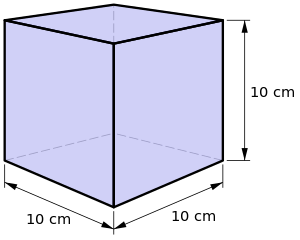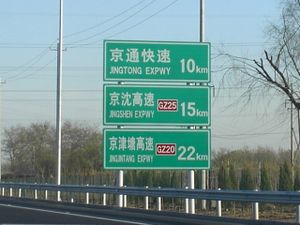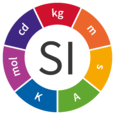النظام الدولي للوحدات
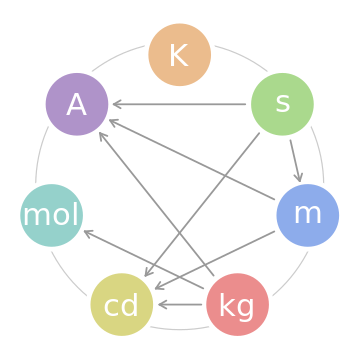
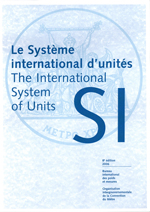
النظام الدولي للوحدات يرمز له بـ (SI) (الأحرف الاولى للمصطلح الفرنسي Système International d'Unités) هو نظام وحدات القياس الأوسع انتشارا في العالم، وهو يستخدم في كل بلدان العالم باستثناء الولايات الامريكية المتحدة. واشتق هذا النظام من نظام متر-كيلوغرام-ثانية للقياس باضافة بعض الوحدات، وكونه بديلا عن نظام السنتمتر-غرام-ثانية القديم يسمى هذا النظام بالنظام المتري (خاصة في الولايات الامريكية المتحدة التي لم تتبناه بشكل واسع وبربطانيا التي لا تزال في مرحلة التحول إلى النظام المتري)، وليست جميع وحدات القياس المترية مقبولة في هذا النظام.
. . . . . . . . . . . . . . . . . . . . . . . . . . . . . . . . . . . . . . . . . . . . . . . . . . . . . . . . . . . . . . . . . . . . . . . . . . . . . . . . . . . . . . . . . . . . . . . . . . . . . . . . . . . . . . . . . . . . . . . . . . . . . . . . . . . . . . . . . . . . . . . . . . . . . . . . . . . . . . . . . . . . . . . .
الوحدات الاساسية
هناك 7 وحدات اساسية في النظام الدولي للوحدات هي:
| المتر | ويقاس بواسطته الطول و يرمز له بال "م" و يحدد المتر الطولي بالطول الموجي لإشعاع ذرة الكريبتون |
| الكيلوغرام | و تقاس بواسطته الكتلة و يرمز له بال "كغم" |
| الثانية | ويقاس بها الزمن و يرمز لها بال "ث" وتحدد بمدة اشعاع ذرة السيزيوم |
| الامبير | ويقاس به شدة التيار الكهربي و يحدد بالقوة الكهروديناميكية بين موصلين |
| الكلفن | وتقاس به درجة الحرارة و يرمز له ب "ك" |
| الشمعة | وتقيس شدة الضوء و ليس لها إختصار (في الإنجليزيه "cd") وهي مقدار الإشعاع الناتج من ذرة البلاتين PT المتجمده |
| المول | وحدة لقياس كمية المادة ويستخدم عادة في الكيمياء، والمول هو عدد أفوجادرو (تقريبا 6.0221415 × 10²³) من الجزيئات الاساسية، سواء كان الحديث يدور عن ذرات او جزيئات لمركب ما. |
Metre Convention
| CGPM Vocabulary | |||||||||||||||
|---|---|---|---|---|---|---|---|---|---|---|---|---|---|---|---|
|
Towards SI
At the close of the 19th century three different systems of units of measure existed for electrical measurements: a CGS-based system for electrostatic units (also known as the Gaussian or ESU system), a CGS-based system for electromechanical units
| Unit name |
Unit symbol |
Quantity name |
Definition (Incomplete)[n 1] | Dimension symbol |
|---|---|---|---|---|
| metre | m | length |
|
L |
| kilogram[n 2] | kg | mass |
|
M |
| second | s | time |
|
T |
| ampere | A | electric current |
|
I |
| kelvin | K | thermodynamic temperature |
|
Θ |
| mole | mol | amount of substance |
|
N |
| candela | cd | luminous intensity |
|
J |
The original definitions of the various base units in the above table were made by the following authorities:
All other definitions result from resolutions by either CGPM or the CIPM and are catalogued in the SI Brochure. | ||||
| Name | Symbol | Quantity | Expressed in terms of other SI units |
Expressed in terms of SI base units |
|---|---|---|---|---|
| radian | rad | angle | 1 | m/m |
| steradian | sr | solid angle | 1 | m2/m2 |
| hertz | Hz | frequency | s−1 | |
| newton | N | force, weight | kg⋅m⋅s−2 | |
| pascal | Pa | pressure, stress | N/m2 | kg⋅m−1⋅s−2 |
| joule | J | energy, work, heat | N⋅m | kg⋅m2⋅s−2 |
| watt | W | power, radiant flux | J/s | kg⋅m2⋅s−3 |
| coulomb | C | electric charge or quantity of electricity | s⋅A | |
| volt | V | voltage (electrical potential difference), electromotive force | W/A | kg⋅m2⋅s−3⋅A−1 |
| farad | F | electric capacitance | C/V | kg−1⋅m−2⋅s4⋅A2 |
| ohm | Ω | electric resistance, impedance, reactance | V/A | kg⋅m2⋅s−3⋅A−2 |
| siemens | S | electrical conductance | A/V | kg−1⋅m−2⋅s3⋅A2 |
| weber | Wb | magnetic flux | V⋅s | kg⋅m2⋅s−2⋅A−1 |
| tesla | T | magnetic field strength | Wb/m2 | kg⋅s−2⋅A−1 |
| henry | H | inductance | Wb/A | kg⋅m2⋅s−2⋅A−2 |
| degree Celsius | °C | temperature relative to 273.15 K | K | |
| lumen | lm | luminous flux | cd⋅sr | cd |
| lux | lx | illuminance | lm/m2 | m−2⋅cd |
| becquerel | Bq | radioactivity (decays per unit time) | s−1 | |
| gray | Gy | absorbed dose (of ionizing radiation) | J/kg | m2⋅s−2 |
| sievert | Sv | equivalent dose (of ionizing radiation) | J/kg | m2⋅s−2 |
| katal | kat | catalytic activity | s−1⋅mol | |
| Notes 1. The radian and steradian, once given special status, are now considered dimensionless derived units.[2] 2. The ordering of this table is such that any derived unit is based only on base units or derived units that precede it in the table. | ||||
Prefixes
Non-SI units accepted for use with SI
. . . . . . . . . . . . . . . . . . . . . . . . . . . . . . . . . . . . . . . . . . . . . . . . . . . . . . . . . . . . . . . . . . . . . . . . . . . . . . . . . . . . . . . . . . . . . . . . . . . . . . . . . . . . . . . . . . . . . . . . . . . . . . . . . . . . . . . . . . . . . . . . . . . . . . . . . . . . . . . . . . . . . . . .
Unit names as adjectives
In English, a space is recommended between the number and the unit symbol when used as an adjective, e.g. "a 25 kg sphere".
The normal rules of English apply to unit names, where a hyphen is incorporated into the adjectival sense, e.g. "a 25-kilogram sphere".[6]
Chinese and Japanese
Printing SI symbols
Further rules[Note 2] are specified in respect of production of text using printing presses, word processors, typewriters and the like.
Realisation of units
United Kingdom and the former Empire
United States

Even though Congress set up a framework for the use of the metric system in the nineteenth century,[8][Note 3] the United States continues to use customary units for most purposes apart from science and medicine,[9] though as a result of their Spanish heritage, metric units are used widely in Puerto Rico.[10]

الاتحاد الاوروبي
"New SI"
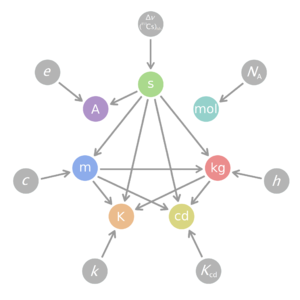
انظر أيضاً
الهامش
- ^ International Bureau of Weights and Measures (2006). Le Système international d'unités (SI) – The International System of Units (SI) (PDF) (8th ed.). ISBN 92-822-2213-6
{{cite book}}: CS1 maint: postscript (link) - ^ أ ب ت خطأ استشهاد: وسم
<ref>غير صحيح؛ لا نص تم توفيره للمراجع المسماةNIST330 - ^ Quantities Units and Symbols in Physical Chemistry, IUPAC
- ^ Page, Chester H; Vigoureux, Paul, eds. (20 May 1975). The International Bureau of Weights and Measures 1875–1975: NBS Special Publication 420. Washington, D.C.: National Bureau of Standards. pp. 238–244.
- ^ McKenzie, A.E.E (1961). Magnetism and Electricity. Cambridge University Press. p. 322.
- ^ "USMA FAQ on hyphenation for adjective forms". Retrieved 2 April 2014.
- ^ "Avogadro Project". National Physical Laboratory. Retrieved 2010-08-19.
- ^ Barbrow, Louis E.; Judson, Lewis V. (March 1976) [First published October 1963]. "Weights and Measures Standards of the United States – A brief history, Special Publication 447". National Bureau of Standards. pp. 10–20. LCCN 76-600055.
- ^ "Appendix G : Weights and Measures". The World Factbook. Central Intelligence Agency. Retrieved 2011-09-03.
- ^ Porter, Darwin; Prince, Danforth (2006). Frommer's Puerto Rico (8th ed.). Wiley Publishing. p. 58. ISBN 978-0-471-78740-2.
وصلات خارجية
- رسمية
- BIPM Bureau International des Poids et Mesures (SI maintenance agency) (home page)
- BIPM brochure (SI reference)
- ISO 80000-1:2009 Quantities and units – Part 1: General
- NIST Official Publications
- Rules for SAE Use of SI (Metric) Units
- النظام الدولي للوحدات at the Open Directory Project
- EngNet Metric Conversion Chart Online Categorised Metric Conversion Calculator
- U.S. Metric Association. 2008. A Practical Guide to the International System of Units
- تاريخ
- LaTeX SIunits package manual gives a historical background to the SI system.
- Electrical units history.
- أبخاث
- Pro-metric advocacy groups
- Pro-customary measures pressure groups
خطأ استشهاد: وسوم <ref> موجودة لمجموعة اسمها "Note"، ولكن لم يتم العثور على وسم <references group="Note"/>


